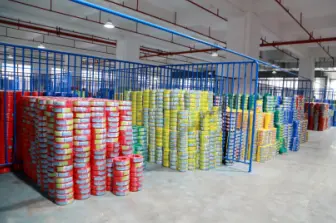Why Are Fire Resistant Electrical Cables No Longer Fire-resistant?
Nowadays, with the continuous development of various industries, many fields need to use wires and cables. We all know that wires and cables are generally made of flammable materials such as plastic or rubber. Once a fire occurs, the consequences will be unimaginable. Therefore, fire-resistant cables such as fire resistant electrical cables are also available. In order to improve the safety of cables, some people will choose to add the cable wrapping layer to fire resistant electrical cables. So, is it really more favorable for the use of cables? Let's talk about how the cable wrapping affects the fire resistance of fire resistant electrical cables.
1. What is the cable wrap of fire resistant electrical cables
What is the cable wrap? The cable wrapping layer is one or two layers of protective layer wrapped around the cable conductor insulation layer or inner sheath layer, also called the liner layer. The main functions are as follows: one is to protect the insulation or inner sheath layer from being damaged by the armor when the cable is armored, and to act as a buffer and cushion. The other is that in the process of cable use, different materials have different effects on the cable insulation or inner sheath layer, such as heat insulation, anti-corrosion, and anti-aging. The wrapping tape materials include polyimide film, polytetrafluoroethylene film, polyester film, nylon tape and so on.
2. The influence of the cable wrapping layer on the performance of fire resistant electrical cables
How does the cable wrap affect the fire resistance of fire resistant electrical cables? The insulation materials of fire-resistant cables are generally PVC, PE, XLPE, etc. The purpose of the insulation layer is to ensure the electrical performance of the cable under normal conditions and the protection of the fire-resistant layer. It does not determine the fire-resistant characteristics of the cable. However, consideration should be given to the effect of the insulating layer state on the refractory layer during high temperature combustion.
If the wrapping layer is a combustible non-woven fabric or PVC tape, it is basically burned out together with the insulation when it is burned, so that the stress deformation caused by temperature fluctuations can have enough space to spread out and release. Thus, compression damage is small, so it has less impact on fire resistance. If the cable wrapping layer is glued glass ribbon or mica tape, the insulating material will not be in direct contact with the flame and burned out during combustion, but heated and melted because the wrapping layer has a certain fire-proof performance. Due to the fastening effect of the cladding layer, the stress and deformation caused by the melting of the insulating material cannot be released outwards, which causes the refractory layer to withstand a large squeeze impact force. In addition, if the cable is armored, the stress and deformation produced by the steel strip will also be applied to the refractory layer when the temperature changes, which will cause the fire resistance performance to decrease and make the refractory layer suffer more damage.
Nowadays, wires and cables are used everywhere, and the probability of disasters is relatively high. Therefore, fire resistant electrical cable s can play an important role in fires. The fire resistant electrical cable s we produce have excellent fire resistance, heat resistance, aging resistance and mechanical properties. Welcome to consult and buy!
Latest News & Blog
 English
English  français
français  Deutsch
Deutsch  العربية
العربية  tiếng việt
tiếng việt  ไทย
ไทย  čeština
čeština  Indonesia
Indonesia  Eesti
Eesti  български
български  slovenčina
slovenčina 



